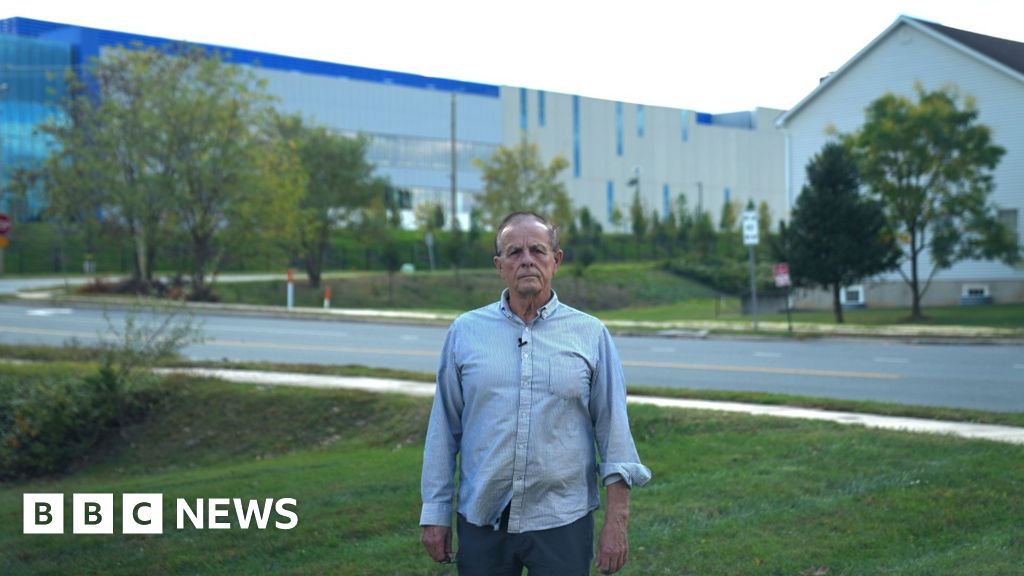Ana Faguyin Loudon County, Virginia
Watch: Loudoun County residents show “mammoth” data centres near their homes
When you cross into Loudon County, Virginia, one of the first things you notice is the hum – that’s the sound of 199 data centres whirring in the background.
Few people have heard of this inconspicuous part of northern Virginia, which also happens to be the wealthiest county in America. But Loudon was on everyone’s radar earlier this week, when a massive global Amazon outage downed everything from crucial banking services to fun Snapchat streaks for millions.
That’s because the county is home to the world’s largest swath of data storage and processing facilities – even outpacing China.
Data centres – dedicated spaces for computer systems that help power the internet and artificial intelligence – are essential to our global connectivity.
But while they have proven to be a lucrative business – contributing billions to the local economy – some residents worry the cost comes at too high a price.
Meiying Wu
A data centre in Loudoun County.
There are some 200 facilities taking up about 45 million square metres in Loudoun, giving the county the nickname Data Center Alley.
Data centres take up 3% of the total land area of the county and 40% of its budget.
And now more facilities are on their way.
Emily Kasabian was walking her newborn son along her picturesque neighbourhood road in Virginia earlier this year, when she saw something that stopped her in her tracks.
A sign for a proposed data centre moving in across the street.
Two years ago, when Ms Kasabian purchased her home she said she was relieved to be away from the data centres that have taken over other parts of the county. The lack of centres nearby was the reason many of her neighbours chose to live there, she said.
“I never thought that a data centre would be built across the street from my house,” she said. “I would not have bought this house if I had known what was going in across the street.”
The reason she, and so many others, are opposed to these large facilities is not just because of their overpowering appearance – a typical data centre can be 100,000 square feet, turning whole streets into large industrial blocks – but some of their side effects, too.
A massive bright blue concrete and glass data centre sits just steps from Greg Pirio’s front door in Loudoun County. Thirteen years ago when he purchased his home that patch of land was filled with green trees and chirping birds.
Today, he deals with the centre’s impacts in real time – the one that bothers him the most is the noise pollution.
“There are no birds around here anymore,” he said, noting the humming or buzzing noise the centre emits scares away a lot of wildlife from his area.
Getty Images
Data centres can raise the electricity rates of everyone around them
In addition to the noise concerns, people who live in the area expressed frustration with rising electricity bills.
In the past five years, wholesale electricity costs have gone up by as much as 267% in areas near data centres, an investigation by Bloomberg News found.
But while most locals the BBC spoke to opposed the data centres, the industry has many powerful proponents, including President Donald Trump.
Data centres are essential to help grow the burgeoning industry of AI, a field that Trump has said he wants the United States to lead in.
His administration has said it will “accelerate federal permitting of data center infrastructure” to conjure “a golden age for America manufacturing and technology”.
The centres can have big impacts on local and state economies, too. Annually, the data centre industry creates about 74,000 jobs, totalling $5.5bn (£4bn) in labour income to Virginia’s economy, according to a state audit.
Meiying Wu
Emily Kasabian in front of a substation near her house.
Loudoun County was among the first to see the potential, about a decade ago, and begin growing this new industry.
Developers realised the area was the perfect place for data centres – it was filled with flat, cheap land.
Local officials soon got on board and began giving corporations like Amazon and Google the green light to start building their facilities.
And the area had one more thing going for them in their quest to create a headquarters for a new burgeoning industry: the right talent.
“Northern Virginia was really at the centre for the growth of the internet, [it was] where AOL was headquartered, and so naturally they have the talent, they have the people already there, it was just easier to make [the data centres] there,” Thomas Hyslip, a cybersecurity expert, said.
Since the industry began booming rapidly earlier this century, regulations on the centres have been limited.
Virginia’s Governor, Glenn Youngkin, vetoed state legislation that would have regulated the centres earlier this year.
Dan Diori, vice president of state policy at the Data Center Coalition, an industry group, said the industry needed to do a better job communicating the up-sides of these centres, and listening to people’s concerns. But he doesn’t think more regulation is necessary.
Data centres are not going anywhere, he said. They are and will continue to be the “backbone of the 21st century economy”.
But some residents, like Barbara Day, say people shouldn’t have to choose between the economy and quality of life.
“These data centres are going up faster than we realised the implications of and then we’re back-paddling to fix it,” she said.
Market reports show that in August 2025, there were currently more than 1,100 data centres across the US, with almost 400 new centres being built.
Activists like Ms Kasabian hope to chip away at those numbers, by lobbying state and local legislatures to delay or pause projects.
“This is a beautiful great place to live, but if this type of development continues to happen and they allow it to encroach they are eroding what makes this a great place to live and we’ll start to see the consequences of that soon unless we start to course correct in a very major way,” she said.
The mother of two knows she may not win this battle and the data centres may soon appear across the street from her idyllic suburban neighbourhood, forcing her family to make the difficult decision to move.
“The question is, well, do we want to stay in the county, how do we know where we move next the same thing isn’t going to happen?”
Video by Meiying Wu







